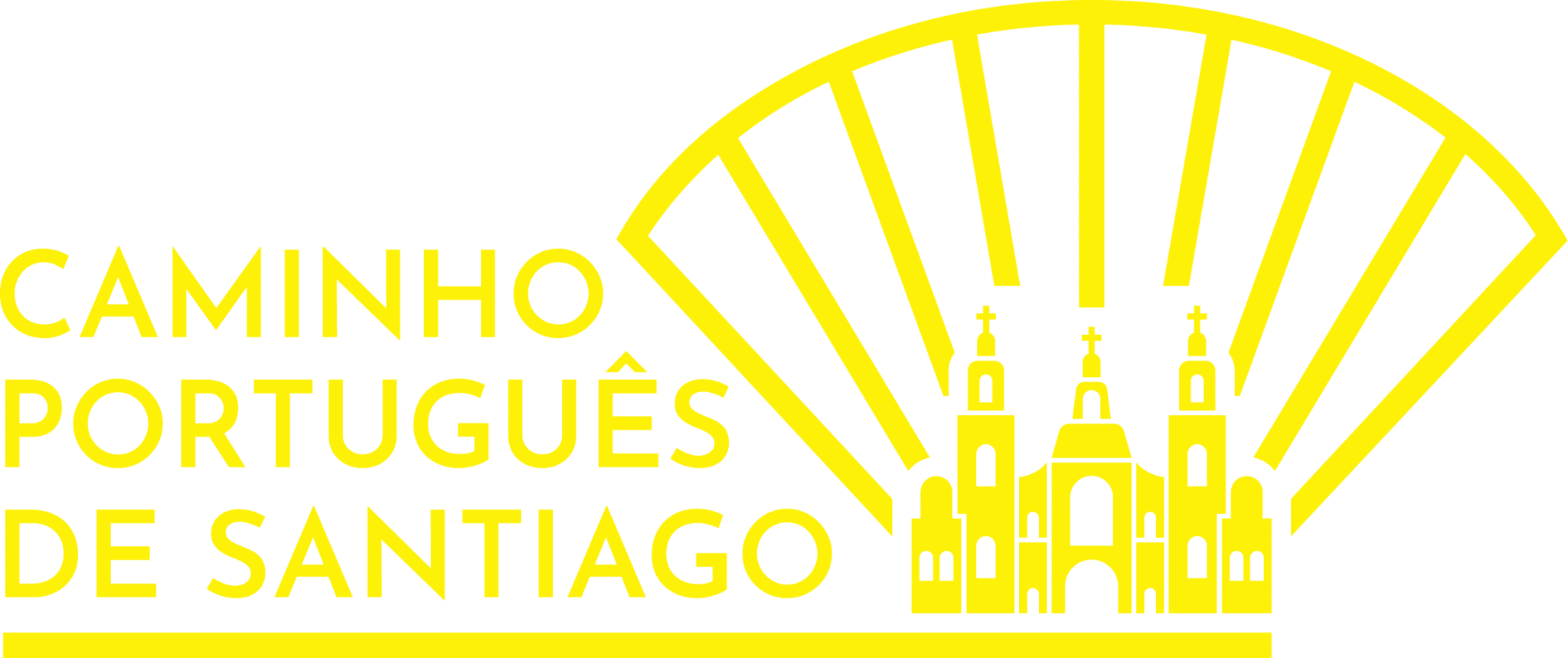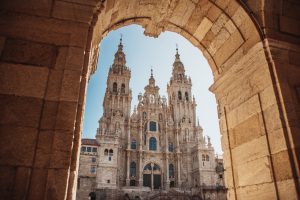This article has one mission: to let you know about the fantastic Jacobean organization that we have chosen to support with 50% of the profits from the sale of our Social Calendar: the Association of Friends of the Camino de Santiago de Viana do Castelo.
The Association of Friends of the Camino de Santiago de Camino de Santiago de Viana do Castelo has revived the Portuguese Coastal Way, which has been undiscovered for centuries. It was their effort and dedication to the pilgrimage cause that led them to study and search for information that was thought to have been lost to time. They tried to signpost the route, obeying the centuries of history and with the safety of the pilgrim always in mind. They have contributed greatly to raising awareness in the community about the dynamics associated with the Jacobean route. In this way, we hope to be able to convey their value in these words that seem too short to express the admiration we have for each and every one of the people who made up the group that gave new worlds to the Costa's trajectory.
Por isso, quando tivemos a ideia para o Calendário Social do Caminho Português de Santiago de 2023, este foi o primeiro grupo que nos veio à memória. Queres conhecer melhor estes entusiastas do trilho milenar e perceber o porquê de terem sido os escolhidos?
Read this article to the end!
Who is the Association of Friends of the Camino de Santiago de Viana do Castelo?
The Association of Friends of the Camino de Santiago de Camino de Santiago de Viana do Castelo or AACS-Viana, as it is also known, is a Jacobean group created by pilgrims. As such, all its activities serve the people who venture along our wonderful route.
Born, as the name suggests, in Viana do Castelo, it was in 2004 that this institution was made official. Its mission was, and is, to bring the experience of "Being a Pilgrim" to more people and, at the same time, to promote the Portuguese Camino de Santiago.
It must be said that few do it as well as the protagonist of this article.
Not only is its history intimately and deeply linked to the Portuguese Coastal Way as we know it today, but it is also responsible for running one of the pilgrim hostels that best represents the spirit of this adventure through Portuguese territory.
The history of the Association.
The chronology of the AACS goes hand in hand with the development of the Camino de Santiago in Portugal. This is because, after years without much expression, these ancient routes have been rediscovered by scholars and other lovers of this adventure. So, together they have been unraveling the skein of clues left by ancient pilgrims and the infrastructures that housed them, until they have uncovered all the evidence.
In Spain, this was the case with Father Elias Valinã's research, launched in the 1970s. This, with the encouragement of the priest who, by his hand, marked the famous yellow arrows, was the pioneering impulse that revived enthusiasm for the ancient route.
However, associations were also crucial in this joint reconstruction. For example, in Portugal, in order to breathe new life into the Camino Camino de Santiago, which we know today as Central, three Jacobean associations joined forces in 2002: the AACS-North of Portugal, the AGACS Asociación Galega Amigos do Camiño de Santiago and the AVACS Associação de Valença dos Amigos do Camino de Santiago de Santiago. In 2006, they finished marking the route that leaves Lisbon and continues through central Portugal.
Imbued with determination, in the year of the Euro soccer championship in our country, a group of experienced pilgrims created the Association of Friends of the Camino de Santiago de Viana do Castelo.
The objectives were simple: to make the route in Lusitanian lands grow, but also to explore a mysterious route in the coastal north. It had documentation and bibliography. However, the most important thing remained to be done: to identify, signpost and publicize the Portuguese Coastal Path.
And that's what they did between 2005 and 2010. Over these five years, they introduced yellow arrows along the seaside route to guarantee a guided experience along the historic route. On their side was history and the marks it leaves on the territories, which are visible to the naked eye in the various religious buildings and monuments found along the route, such as monasteries and churches.
The Portuguese Coastal Path.
The real Portuguese Coastal Way is regularly confused with its modern variation, the Senda Litoral. Although the latter is a crossing full of life and unique beauty, this trail is just a path promoted by Galicia, which quickly realized the added value of the route being included in the Camino de Santiago.
But that's not all, as the Lusitanian route suffers from its own beauty. The proximity to the sea and the creation of footbridges by local authorities have distorted the ancient route that has been walked by pilgrims for centuries. The Camino de Santiago is originally a historic Christian pilgrimage route. Its original layout must, of course, always have been associated with Roman or medieval routes, churches, convents, shrines, crosses, palaces, among other religious representations. What is happening today is that we are seeing new routes spring up outside these natural indicators of the Way.
However, you only have to follow common sense to understand that it wouldn't have made sense for pilgrims of yesteryear to make the effort to cross the water flow between Caminha and A Guarda.
Firstly, it was an added difficulty on what was already a dangerous journey. Secondly, the people making the sacred journey wanted to reach their destination quickly. In other words, they weren't going to add days to their journey by going backwards.
So, to follow the Portuguese Coastal Route, you have to leave Porto and go as far as São Pedro de Rates. Then it turns towards the ocean, passing through towns such as Fão, Esposende and Marinhas. It's on this trail that you'll find the oldest reference to the Camino de Santiago in Portugal. In Castelo do Neiva, in the town's parish church, there is an evocation of Santiago dating from 862. It was found during restoration work on the building, and the record is that of D. Nausti, the former bishop of Coimbra. For those who live in the sacred area, it's a must-see.
From Caminha, continue through the national territory. Keeping up with the river, you can stop in Vila Nova de Cerveira and Valença do Minho, where you'll find the Central Way again.
The Caminha Hostel.
Back to our protagonists. With the signage complete, part of the initial objective had been accomplished. So now it was time for a new phase. This came in 2012, when the Town Hall and the Santa Casa da Misericórdia de Caminha inaugurated the Pilgrims' Hostel in this town, with 32 beds. It was managed by our favorite association, which continues today to run the place seriously and with the open-mindedness typical of pilgrims to Compostela.
The Albergue de Caminha is therefore special because it is made by people who, through their work, have recovered an important route and therefore treat it as a treasure shared by all. So when you approach the white doors that make up the entrance, you feel like you've come home.
Here, pilgrims dine together, sing and form lifelong friendships. If you pass through the town that borders the sea, you know that here you'll receive a warm welcome from the volunteers who do an excellent job of hosting and facilitating pilgrim conversations.
Enjoy!
The Social Calendar of the Portuguese Camino de Santiago.
So now you can see why we have a special affection for this association. It's because of their good work over the years that we've chosen them to take part in our calendar, which you can now buy here!
To help, 50% of the profits from the sales of our community calendar will go to AACS. With this money, the association will embark on a new adventure: rediscovering the fantastic Camino del Norte, just as they did with the coastal route. This ancient crossing is somewhere between the central route and the coastal route. With your help, they'll be able to buy yellow paint to mark the trail, pay for transportation and even feed themselves during what is expected to be a tough journey!







When they say shipping on January 9th and 10th, does that mean that any order placed after those dates is void? Why do they keep the purchase option open? I've already paid for the calendar and shipping costs, how will I be reimbursed? I'd appreciate a reply as soon as possible to this comment and the two emails I've sent in the meantime.